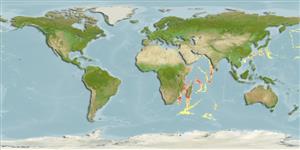Teleostei (teleosts) >
Lophiiformes (Anglerfishes) >
Ogcocephalidae (Batfishes)
Etymology: Halieutopsis: Greek, halieutis = fisher + Greek, opsis = apperance (Ref. 45335); ingerorum: Named for Robert F. Inger.
Eponymy: Dr Robert ‘Bob’ Frederick Inger (d: 1920–2019) was an American herpetologist and ichthyologist. [...] (Ref. 128868), visit book page.
Environment: milieu / climate zone / depth range / distribution range
Ecology
Marine; bathydemersal; depth range 1300 - 1600 m (Ref. 127411). Deep-water
Southwest Indian Ocean: South Africa, Madagacar and Mozambique Channel.
Size / Weight / Age
Maturity: Lm ? range ? - ? cm
Max length : 4.4 cm SL (female)
Short description
Identification keys | Morphology | Morphometrics
Dorsal soft rays (total): 5; Anal soft rays: 4; Vertebrae: 20. Jaws short, strongly curved. Mouth narrow. Face strongly upturned; gape nearly vertical; rostrum very abbreviated, tipped upward, set back to anterior margin of eyes. Outline of disk oval, cranium slightly elevated above general disk surface. Tail slender, tapered toward caudal. Esca with ventral lobes lentil-shaped, dorsal lobe folded and wrinkled. Illicial cavity small with esca slightly exerted from illicial opening. Cephalic lateral line scale counts: preopercular 2; subopercular 5; dorsolateral branch of subopercular 3; supraorbital 3. Lateral line scale counts on body 9-10; tail 13. Ventral surface of disk, except the lateral line scales on either side of anus, and skin around eyeballs without tubercles, Gill rakers cone-shaped with tiny teeth clustered distally on each. Paired fins small and weak. Dorsal and anal fins somewhat abraded but clearly small; anal fin lappet-like (Ref. 40825).
Life cycle and mating behavior
Maturity | Reproduction | Spawning | Eggs | Fecundity | Larvae
Ho, H.-C., 2021. Taxonomy and distribution of the deep-sea batfish genus Halieutopsis (Teleostei: Ogcocephalidae), with descriptions of five new species. J. Mar. Sci. Eng. 10(1):34. (Ref. 127411)
IUCN Red List Status (Ref. 130435: Version 2024-1)
Threat to humans
Harmless
Human uses
Fisheries: of no interest
Tools
Special reports
Download XML
Internet sources
Estimates based on models
Preferred temperature (Ref.
123201): 1.9 - 4.3, mean 2.8 °C (based on 166 cells).
Phylogenetic diversity index (Ref.
82804): PD
50 = 0.5010 [Uniqueness, from 0.5 = low to 2.0 = high].
Bayesian length-weight: a=0.02344 (0.00968 - 0.05678), b=2.94 (2.73 - 3.15), in cm total length, based on LWR estimates for this (Sub)family-body shape (Ref.
93245).
Trophic level (Ref.
69278): 3.2 ±0.5 se; based on size and trophs of closest relatives
Resilience (Ref.
120179): High, minimum population doubling time less than 15 months (Preliminary K or Fecundity.).
Fishing Vulnerability (Ref.
59153): Low vulnerability (10 of 100).
